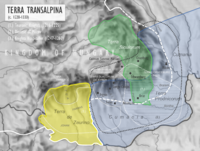
Farcaş
Encyclopedia

Béla IV of Hungary
Béla IV , King of Hungary and of Croatia , duke of Styria 1254–58. One of the most famous kings of Hungary, he distinguished himself through his policy of strengthening of the royal power following the example of his grandfather Bela III, and by the rebuilding Hungary after the catastrophe of the...
(1235-1270) on 2 July 1247; the diploma granted territories to the Knights Hospitaller
Knights Hospitaller
The Sovereign Military Hospitaller Order of Saint John of Jerusalem of Rhodes and of Malta , also known as the Sovereign Military Order of Malta , Order of Malta or Knights of Malta, is a Roman Catholic lay religious order, traditionally of military, chivalrous, noble nature. It is the world's...
in the Banate of Severin
Banate of Severin
-References:*George Popoviciu, Istoria românilor bănăţeni, Lugoj, 1904*Patriciu D., Istoria Banatului Severin, Tipografia Diecezană, Caransebeş, 1899....
and Cumania
Diocese of Cumania
The Diocese of Cumania was a Roman Catholic diocese in Hungary.The diocese was founded in 1227 with its seat in Milcov, serving the Cumans and the Teutonic Knights in the Burzenland. The diocese was destroyed during the course of the Mongol invasion of Europe in 1241.It was a suffragan of the...
. Farcaş held a kenazate which was given to the knights by the king. His kenazate lay in the northeast of modern Oltenia
Oltenia
Oltenia is a historical province and geographical region of Romania, in western Wallachia. It is situated between the Danube, the Southern Carpathians and the Olt river ....
(in Romania
Romania
Romania is a country located at the crossroads of Central and Southeastern Europe, on the Lower Danube, within and outside the Carpathian arch, bordering on the Black Sea...
).
The diploma of Béla IV also refers to the kenazates of John
John (knez)
John, also Joan or Ioan, was a cneaz mentioned in a diploma issued by king Béla IV of Hungary on 2 July 1247; the diploma granted territories to the Knights Hospitaller in the Banate of Severin and Cumania. John held a kenazate which was given to the knights by the king...
and voivode Litovoi
Litovoi
Litovoi, also Litvoy, was a Vlach voivode in the 13th century whose territory comprised northern Oltenia .He is mentioned for the first time in a diploma issued by king Béla IV of Hungary on 2 July 1247...
and to voivode Seneslau
Seneslau
Seneslau, also Seneslav or Stănislau, was a Vlach voivode mentioned in a diploma issued by king Béla IV of Hungary on 2 July 1247; the diploma granted territories to the Knights Hospitaller in the Banate of Severin and Cumania...
. Seneslau and Litovoi are expressly said to be Vlachs (Olati) in the king's diploma.
Farcaş (Farkas) is a typical Hungarian
Hungarian language
Hungarian is a Uralic language, part of the Ugric group. With some 14 million speakers, it is one of the most widely spoken non-Indo-European languages in Europe....
name meaning ‘wolf’. The Romanian historian Ioan Aurel Pop suggests that his name is mentioned in Hungarian translation in the diploma, and Farcaş's kenazate was one of the incipient Romanian states south of the Carpathian Mountains
Carpathian Mountains
The Carpathian Mountains or Carpathians are a range of mountains forming an arc roughly long across Central and Eastern Europe, making them the second-longest mountain range in Europe...
.
According to the Hungarian historian István Vásáry, Farcaş was either Hungarian or Romanian with Hungarian name, but the latter supposition is less probable, since Lupu, the Romanian equivalent of Hungarian Farkas, was used by the Romanians.
László Makkai proposes that the name of Vâlcea County
Vâlcea County
Vâlcea is a county of Romania, in the historical regions of Oltenia and Muntenia...
could indicate the land of Farcaş (Slavic
Slavic languages
The Slavic languages , a group of closely related languages of the Slavic peoples and a subgroup of Indo-European languages, have speakers in most of Eastern Europe, in much of the Balkans, in parts of Central Europe, and in the northern part of Asia.-Branches:Scholars traditionally divide Slavic...
vlk (‘wolf’) > Vâlcea).
Sources
- Georgescu, Vlad (Author) – Calinescu, Matei (Editor) – Bley-Vroman, Alexandra (Translator): The Romanians – A History; Ohio State University Press, 1991, Columbus; ISBN 0-8142-0511-9
- Klepper, Nicolae: Romania: An Illustrated History; Hippocrene Books, 2005, New York; ISBN 0-7818-0935-5
- Makkai, László: From the Hungarian conquest to the Mongol invasion; in: Köpeczi, Béla (General Editor) – Makkai, László; Mócsy, András; Szász, Zoltán (Editors) – Barta, Gábor (Assistant Editor): History of Transylvania - Volume I: From the beginnings to 1606; Akadémiai Kiadó, 1994, Budapest; ISBN 963-05-6703-2
- Pop, Ioan Aurel: Romanians and Romania: A Brief History; Columbia University Press, 1999, New York; ISBN 0-88033-440-1
- Rady, Martyn: Nobility, Land and Service in Medieval Hungary; Palgrave (in association with School of Slavonic and East European Studies, University College London), 2000, New York; ISBN 0-333-80085-0
- Spinei, Victor: The Romanians and the Turkic Nomads North of the Danube Delta from the Tenth to the Mid-Thirteenth Century; Brill, 2009, Leiden and Boston; ISBN 978-90-04-17536 5
- Vásáry, István: Cumans and Tatars: Oriental Military in the Pre-Ottoman Balkans, 1185-1365; Cambridge University Press, 2005, Cambridge; ISBN 0-521-83756-1

